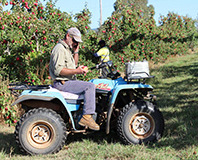Read the latest information on
Foot-and-mouth disease

Farm Biosecurity interviews 1200 producers from across Australia every couple of years, no matter where you happen to be (as long as you have reception)
Every couple of years the Farm Biosecurity Program, run by Plant Health Australia and Animal Health Australia, conducts a national phone survey of about 1200 producers.
Both crop and livestock producers are asked what they think about biosecurity, what kind of information they need and how they like to receive it.
There are questions about crop and livestock monitoring, reporting of pests and diseases, what biosecurity measures are used on farm and the benefits of implementing biosecurity measures.
All this is so that both companies can continue to meet the needs of producers when it comes to biosecurity.
The survey ‘field’ work – literally, many of the interviews happen on a mobile phone in the paddock – will be starting soon.
We know you’ve been through a lot recently – drought, fires, floods, you name it – but don’t think it doesn’t apply to you.
Surveys like this allow you to have a say on how we can better help your management decisions when it comes to biosecurity. Before it even starts, thank you to everyone who agrees to participate in the survey. The time you take to answer the questions is appreciated.
After the research is done, summaries of the information will be published over the coming months, letting you all know how it went.
Don’t worry if you miss out on the survey: you can still tell us what you think of the Farm Biosecurity Program via our Contact Form.
Do you like the newsletter? Is there anything extra would you like to see? What resources do you need to help implement biosecurity on-farm?
Thanks for your suggestions.